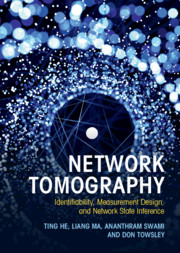Book contents
- Frontmatter
- Contents
- Notation
- Introduction
- 1 Preliminaries
- 2 Fundamental Conditions for Additive Network Tomography
- 3 Monitor Placement for Additive Network Tomography
- 4 Measurement Path Construction for Additive Network Tomography
- 5 Fundamental Conditions for Boolean Network Tomography
- 6 Measurement Design for Boolean Network Tomography
- 7 Stochastic Network Tomography Using Unicast Measurements
- 8 Stochastic Network Tomography Using Multicast Measurements
- 9 Other Applications and Miscellaneous Techniques
- Appendix Datasets for Evaluations
- Index
7 - Stochastic Network Tomography Using Unicast Measurements
Published online by Cambridge University Press: 25 May 2021
- Frontmatter
- Contents
- Notation
- Introduction
- 1 Preliminaries
- 2 Fundamental Conditions for Additive Network Tomography
- 3 Monitor Placement for Additive Network Tomography
- 4 Measurement Path Construction for Additive Network Tomography
- 5 Fundamental Conditions for Boolean Network Tomography
- 6 Measurement Design for Boolean Network Tomography
- 7 Stochastic Network Tomography Using Unicast Measurements
- 8 Stochastic Network Tomography Using Multicast Measurements
- 9 Other Applications and Miscellaneous Techniques
- Appendix Datasets for Evaluations
- Index
Summary
Chapters 7 and 8 are designated for network tomography for stochastic link metrics, which is a more fine-grained model than the models of deterministic additive/Boolean metrics, capturing the inherent randomness in link performances at a small time scale. Referred to as stochastic network tomography, these problems are typically cast as parameter estimation problems, which model each link metric as a random variable with a (partially) unknown distribution and aim at inferring the parameters of these distributions from end-to-end measurements. Chapter 7 focuses on one branch of stochastic network tomography that is based on unicast measurements. It introduces a framework based on concepts from estimation theory (e.g., maximum likelihood estimation, Fisher information matrix, Cramér–Rao bound), within which probing experiments and parameter estimators are designed to estimate link parameters from unicast measurements with minimum errors. Closed-form solutions are given for inferring parameters of packet losses (i.e., loss tomography) and packet delay variations (i.e., packet delay variation tomography).
Keywords
- Type
- Chapter
- Information
- Network TomographyIdentifiability, Measurement Design, and Network State Inference, pp. 174 - 200Publisher: Cambridge University PressPrint publication year: 2021



